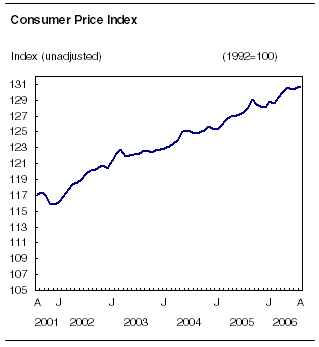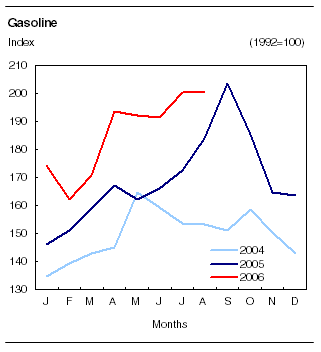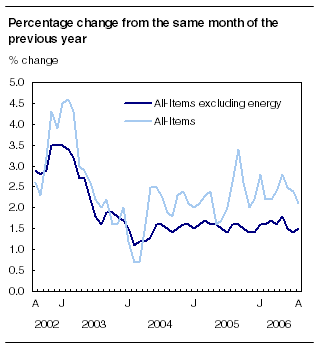Common menu bar links
Consumer Price Index
Archived Content
Information identified as archived is provided for reference, research or recordkeeping purposes. It is not subject to the Government of Canada Web Standards and has not been altered or updated since it was archived. Please "contact us" to request a format other than those available.

In August, despite the strong advance in the housing sector, weakening gasoline prices slowed down the 12-month growth of prices paid by consumers. Between August 2005 and August 2006, the Consumer Price Index (CPI) posted a 2.1% increase, falling back for a third consecutive month. Such a persistent decline in the 12-month variation of the All-items index has not occurred since September 2004.

The decline from 2.4% to 2.1% in the 12-month change of All-items CPI between July and August 2006 was mainly attributable to the slowdown in gasoline prices increase paid by drivers at the pump. Gasoline prices only increased 0.1% from July to August of this year, leading to a slowdown in the 12-month change in the gasoline index which dropped from 16.1% between July 2005 and July 2006 to 9.0% between August 2005 and August 2006.
Excluding energy prices, the 12-month change in the CPI edged up from 1.4% in July 2006 to 1.5% in August 2006. Since June 2004, the increases of this index have ranged from 1.4% to 1.8%, suggesting that inflation has remained in check in the country.
The 12-month change in the All-items CPI excluding eight of the most volatile components identified by the Bank of Canada was 1.5% in August 2006. With the exception of the 2.0% variation posted in May 2006, this index has remained relatively stable over the last year, fluctuating between 1.5% and 1.7%.

The All-items CPI excluding eight of the most volatile components, combined with changes in indirect taxes, constitute the core inflation rate used by the Bank of Canada to define its inflation target.
On a monthly basis, prices paid by consumers continued their upward movement for a second consecutive month between July and August. The CPI rose 0.2% in August, largely as a result of pressures from the housing sector.
The All-items index excluding energy was also up 0.2% in August. This increase comes on the heels of declines of 0.2% recorded during the previous two months.
The same trend was observed for the All-items index excluding eight of the most volatile components identified by the Bank of Canada. The latter increased 0.2% between July and August, after dropping 0.2% during the previous two months.

The All-items index increases as a result of higher prices for gasoline and some housing components
In August 2006, the prices paid by consumers were 2.1% higher than in August 2005, substantially less than the 2.4% rise posted in July.
The rise in gasoline prices between August 2005 and August 2006 again accounted for most of the 12-month increase in the CPI. Gasoline prices advanced 9.0% between August 2005 and August 2006, down from the 16.1% jump observed between July 2005 and July 2006.
During the summer 2006 vacation period, gasoline prices rose much less than they did last year. While prices had shot up 10.8% between June and August 2005, the increase during the same period in 2006 was only 4.7%.
Last year, gasoline prices began their dizzying climb in late August 2005, jumping 6.6% for the month as a whole, a result of the anticipated devastating effects of Hurricane Katrina on refined petroleum production.
The other factors that contributed to the rise in the CPI include components of housing, namely homeowners' replacement cost, mortgage interest cost and electricity prices.
The homeowners' replacement cost index, which captures the worn-out structural portion of housing and is estimated using new housing prices (excluding land), rose by 8.1% between August 2005 and August 2006. The growth in this housing component has advanced every month since December 2005. Since the beginning of the year, the 12-month increases posted by this index were continuously above 5%. Combined with its substantial share in the CPI basket, the rise of the homeowners' replacement index pushed up the CPI All-items index.
The growth of replacement cost varied widely from one province to another, ranging from 43.4% in Alberta to close to 4% in other large provinces such as Ontario (+3.9%), Quebec (+3.5%) and British Columbia (+3.6%).
By all counts, Alberta's housing sector stands out clearly from that of the other provinces. The boom in the oil sector, combined with a high employment rate and a high degree of consumers' confidence, translated into a surge in demand for new houses in that province.
The mortgage interest cost index, which captures price-induced changes in the amount of mortgage interest owed by consumers, rose 2.7% between August 2005 and August 2006, a strong advance compared to the 1.8% increase in July.
Although the increase in the value of new properties has largely contributed to the rise of the mortgage interest cost index, the recent turnaround in the interest rates accounted for much of the acceleration of this index. Almost three quarters of the 0.9 percentage point increase in the 12-month variation of the mortgage interest cost index between July and August 2006 came from rising mortgage interest rates.
Adding further pressure to the All-items index, electricity prices climbed 6.3% between August 2005 and August 2006. This increase can largely be explained by rate hikes in Ontario, Alberta, Quebec and British Columbia over the past year.
These price increases were partly offset by lower prices for computer equipment and supplies, women's clothing, video equipment and natural gas.
Prices of information technology products mitigated the 12-month rise in the All-items index. The index for computer equipment and supplies plunged 18.0%, while the video equipment index was down 11.6%. Although consumers only occasionally purchase these products, they exert an important influence in reducing upward price pressures.
Women's clothing prices fell 3.0% between August 2005 and August 2006, contributing to the slowdown in the rise of the CPI. The combined effect of competitive production costs and the strong Canadian dollar exerted a favourable influence on clothing prices sold in specialized boutiques and department stores.
Natural gas prices dropped 2.9% between August 2005 and August 2006. The most substantial decrease was in Alberta (-17.1%), while the largest price increase was in Ontario (+2.9%).
Strong advance in the housing sector pushes up the monthly CPI
After inching up 0.1% between June and July, the All-items index increased 0.2% between July and August 2006.
The upward pressure on the CPI came largely from two housing components: mortgage interest cost and homeowners' replacement cost. Men's clothing prices also contributed to the rise.
Mortgage interest cost increased 0.7% between July and August. Mortgage interest cost has risen every month this year, reflecting the combined effect of higher mortgage rates and appreciation in the value of new properties.
Over the last three months, mortgage interest rates have pulled up the mortgage interest cost index. This constitutes a sharp turnaround compared to the last three years, when declining mortgage interest rates had mitigated the increase in the mortgage interest cost index. This reversal is primarily a reflection of successive mortgage rate increases posted by financial institutions since September 2005.
Homeowners' replacement cost, another major component of housing in the CPI basket, was up 0.7% between July and August. The appreciation in the value of new properties was the source of this increase.
Also pushing up the All-items index, men's clothing prices rose 2.8% between July and August.
Mitigating the upward trend in the monthly index to some extent, prices for the purchase and leasing of automotive vehicles were down 0.8% in August. Car manufacturers offered substantial discounts in order to clear out their 2006 models to make room for the new 2007 models.
Fresh vegetable prices dropped 4.1% between July and August. During this period of the year consumers are able to purchase different types of vegetables harvested locally. Prices therefore drop as a result of the temporary surplus in the supply of vegetables.
Natural gas prices fell 3.0% in August, driven by the 12.0% slide in Alberta. Owing to their close ties to market prices, natural gas prices in Alberta have a tendency to exhibit large fluctuations from one month to another.
Seasonally adjusted CPI increased between July and August
The seasonally adjusted CPI increased 0.2% between July and August 2006. The upward pressure came from the food component (+0.5%), shelter (+0.2%), clothing and footwear (+0.8%), household operations and furnishings (+0.2%), alcoholic beverages and tobacco products (+0.1%), and health and personal care (+0.1%).
The only downward pressure on the seasonally adjusted index came from the transportation sector (-0.3%). The recreation, reading and education index remained unchanged in August.
The seasonally adjusted CPI without eight of the most volatile components identified by the Bank of Canada rose 0.3% between July and August 2006.
All-items index excluding eight of the most volatile components
The All-items CPI excluding eight of the most volatile components, combined with changes in indirect taxes, constitute the core inflation rate used by the Bank of Canada to define its inflation target. These volatile components are fruit, fruit preparations and nuts; vegetables and vegetable preparations; mortgage interest cost; natural gas; fuel oil and other fuel; gasoline; inter-city transportation; and tobacco products and smokers' supplies.
The 12-month increase of this index was 1.5% in August 2006. The primary factors that contributed to this increase were homeowners' replacement cost (+8.1%), electricity prices (+6.3%), prices for restaurant meals (+2.2%) and property taxes (+3.2%). This increase was offset to some extent by lower prices for computer equipment and supplies (-18.0%), women's clothing (-3.0%) and video equipment (-11.6%).
Between July and August 2006, this index rose 0.2%, a reversal from the 0.2% decrease noted the previous month. Men's clothing (+2.8%) and homeowners' replacement cost (+0.7%) pushed up the index, while prices for the purchase and leasing of automotive vehicles (-0.8%) played the largest part in offsetting this increase.
Energy
Following three straight increases over the past three months (+14.1% in May, +11.5% in June and +10.6% in July), the 12-month change in the energy index continued its downward slide, posting a relatively more modest increase of 7.1% in August. Except for natural gas, all other components contributed to the rise of the energy index. Gasoline was the main source behind this increase (+9.0%), followed by electricity (+6.3%), fuel oil (+12.1%) and fuel, parts and supplies for recreational vehicles (+6.9%). Conversely, natural gas prices were down for the second month in a row. The 2.9% decrease posted in August was largely the result of the 17.1% drop recorded in Alberta.
On a monthly basis, the energy index slipped 0.2% between July and August 2006 as a result of a 3.0% decline in natural gas prices — the only component which posted lower prices. Gasoline (+0.1%) and fuel, parts and supplies for recreational vehicles (+0.2%) increased slightly, while prices for electricity and fuel oil remained unchanged.
Available on CANSIM: tables 326-0001, 326-0002, 326-0009, 326-0012 and 326-0016 to 326-0018.
Definitions, data sources and methods: survey number 2301.
More information about the concepts and use of the CPI are also available online in Your Guide to the Consumer Price Index (62-557-XIB, free) from the Publications module of our website.
Available at 7 a.m. online from The Daily module of our website.
The August 2006 issue of the Consumer Price Index, Vol. 85, no. 8 (62-001-XIB, free) is now available from the Publications module of our website. A paper copy is also available (62-001-XPB, $12/$111).
The September 2006 Consumer Price Index will be released on October 20.
For more information, or to enquire about the concepts, methods or data quality of this release, call Client Services Unit (toll-free 1-866-230-2248; 613-951-9606; fax 613-951-1539; prices-prix@statcan.gc.ca), Prices Division.


 Table(s).
Table(s).